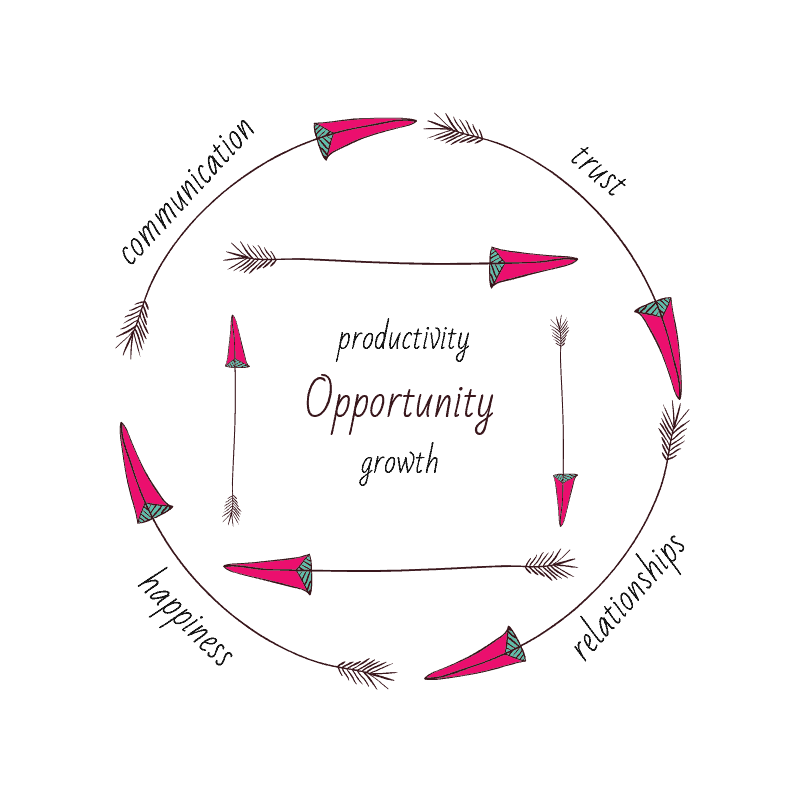3 Ways to Build Trust with Your Remote Team
Build trust with your remote team and show them how to trust you, too.
1. Take a leap of faith.
 Dive in! Build trust with your employees! Easier said than done, right?
Dive in! Build trust with your employees! Easier said than done, right?
Think of it this way:
Years ago, most of the workforce was hired into a manufacturing economy where managers watched their employees like hawks. This management style was adopted in different ways throughout other fields of work beyond manufacturing. Trust in the workplace didn’t really exist. We no longer live in that world.
According to Unsettled about 50% of the U.S. workforce will be working remotely in some fashion by 2025. And now, this number is shifting even more with many companies reinventing the remote workforce.
People looking for remote work, who crave autonomy, value jobs that give them purpose, and desire schedules that offer more flexibility and balance. This is big. This is an opportunity for every business owner. This means that you now have a potential pool of team members who are looking for a career that they want to truly be a part of and not just a job.
When Opportunity Knocks…
The point here is that you have this immense opportunity at your fingertips to reach out to millions of potential hires all over the world with a myriad of skill sets and abilities. They really want to make this work and be a part of your business. Sure, you may go through a few tough conversations with potential hires or hires that may not be a good fit for one reason or another – but that’s ok, and that will happen.
The good news is, everyone likes and wants autonomy. Great leaders (like you) that are willing and open to leave control-based management behind and embrace a trust-based collaborative environment will end up hiring much more than just one person who you can fully trust.
Communication is the most important part of building and nurturing employees’ trust. (PS. When I mention employees throughout this article, that also includes contractors or freelancers. On my own team, I treat everyone similarly as they’re all a part of my team and in this case, am using that term as a blanket for all hires.)
- Live and breathe to communicate at every step, from work-related tasks to social interactions.
- Make it obvious in your job description that communication is important to you.
- Discuss communication at length throughout the interview process.
- Incorporate communication into your core values. Share these values proudly on your website.
- Encourage it in everything you will do together after they’re hired.
Taking that leap of faith is a beautiful thing. If your employees feel that you visibly show you have their backs from the get-go, they will transparently have yours. It’s been a few years since I’ve hired my first project manager, and it wasn’t even through the comprehensive hiring process we have in place now. *screams of terror*
I simply took a leap of faith.
When hiring though, taking a leap of faith alone might not always be enough. You’ll need to put some things in place to support your initial decision to move forward with a new hire, or it could leave everything that comes afterward completely up to chance. That doesn’t always work out, which brings me to number two…
2. Give them a small test project.
A test project is a smaller task or set of tasks that someone with their skill set should be able to complete within a reasonable amount of time. Most importantly, you are intimately familiar with the test project and understand exactly how it would be completed (there could be more than one way).
You’ve had dinners by candlelight with this test project.
You know this test project’s middle name, it’s third cousin, it’s hopes and dreams.
OK, not really, but you get it—you’ll know when you get the results back if it’s something you can accept as passable or not.
For example, let’s say you want to hire a Virtual Assistant. It’s Monday and you’ve just given them a test project that would take you (at maximum) three hours to complete, even on your least productive day. The deadline is this Friday. You’ve done this kind of thing multiple times, and will be very qualified to determine what action to take after receiving the results. You’ve given them all of the information and resources they would need, if not more, to successfully complete it.
Consider these three test project scenarios.
Scenario #1
You get the test project back next Tuesday. It took twelve hours to complete, and it’s not actually complete. They’ve not asked questions but clearly didn’t understand the tasks you’d given them. This is an obvious, “I do not want to move forward with this hire.”
Scenario #2
Sometimes it’s not so obvious. You get the test project back Thursday afternoon of that same week, so it’s on time. They’ve spent four hours, but asked if that was ok first before proceeding. The task is complete, but not quite up to the quality standards of your business. There are some typos and a few other items that are not correct. Some might be tedious or more time-consuming fixes. However, you really like this person and they really match your core values. This is an, “I want to give this person a second chance by providing constructive feedback because I believe they will be able to learn and grow through experience as they go through our onboarding process, training, and beyond.”
Scenario #3
You get it back in an hour, they’ve spent about forty-five minutes, did more than you asked for, and you couldn’t have done it better yourself. “Shamazing. Let’s do this!”
Ultimately, it is your decision. Even if you decide to move forward in that first scenario. Or, if you have a trusted colleague that’s your go-to for making these kinds of decisions, by all means, start a dialogue around it. Consider their thoughts and also what the rest of your team thinks, too. Remember: Embrace collaboration to establish a relationship, not your inner control-freak. (Don’t worry, everyone has one!) This is another great way to build trust with your employees.
3. Check-in often. Give (constructive, honest) feedback, and give space.
Checking in
 So, this is where it can be really hard to dial down that inner-control freak. This doesn’t mean that you need to check in every five minutes. If a day or two has passed, and you’re kind of expecting them to ask you a question—send a quick note asking them how they’re doing and offer help and guidance if they need it. Basically, just let them know you’re there for them. Even if they’re the type of person who may not always ask for “help” they at least know that you are a go-to resource for that time that they do reach out.
So, this is where it can be really hard to dial down that inner-control freak. This doesn’t mean that you need to check in every five minutes. If a day or two has passed, and you’re kind of expecting them to ask you a question—send a quick note asking them how they’re doing and offer help and guidance if they need it. Basically, just let them know you’re there for them. Even if they’re the type of person who may not always ask for “help” they at least know that you are a go-to resource for that time that they do reach out.
On the other hand, if they’re the type of person who will always ask for help every time they can’t figure something out—still a good thing. That’s actually your opportunity to learn and develop their skills, build even more trust with your employees, and also improve your processes and documentation so that in the future they know exactly where to go to find the best solution.
Giving feedback
Giving feedback is hard. It can be awkward. Sometimes it’s really tough—but it’s necessary. Avoid being critical or harsh, just have that open and honest conversation. This is a safe space to learn and grow – communicate that first. There’s always a learning curve to some degree for everyone, even leaders. Listen to your employees. You will learn from them, too.
Giving space
Finally, autonomy. Give them the space they desire to create amazing things for you and your customers. Get in the habit of always over-communicating when you don’t even have to. That way, they will come to you when a task is done instead of you chasing them down.
Circle of Trust
This all comes full-circle, you’ll see.
- Communication fosters trust.
- Trust builds relationships.
- Good relationships encourage happiness.
- Happiness promotes productivity and growth.
- Growth provides even more opportunities for all of the above and beyond.
Imagine being able to feel this way after onboarding your first hire and every hire after that. It feels AMAZING. I know, I’ve been through this multiple times. It doesn’t get old, it only gets better. My hope is that you get to experience this very same thing, over and over again.
So, take that leap of faith and build trust while hiring your remote team, create those test projects, and really invest in who, how, what, why, and where you communicate. It’s worth every second.